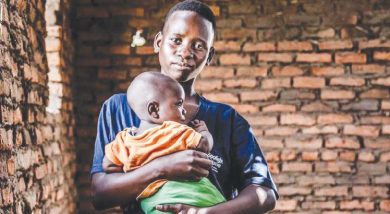Rising from devastation
Four years ago, Evelyn Pondamali and her neighbours looked in disbelief as their nearest health centre in Mulanje West went under water.
The destruction of Nkando Health Centre gave a glimpse of the devastation caused by the floods that hit Mulanje in 2014.
“The water washed away drugs and left part of the facility heavily damaged,” recalls the mother of two.
The trail of destruction reduced the rural health centre’s capacity to serve the community grappling with high disease burden.

Pondamali spoke of death of a patient who could not access medicine at the waterlogged health centre where health workers spent months without providing life-saving services.
“There was not much they could do because the facility was waterlogged. The patient died and the remains laid on the verandah of a retail shop at Nkando Trading Centre because the mortuary too was inaccessible,” she says.
The disaster left people from the area travelling over 20 kilometres to get treatment at Mulanje District Hospital.
“It was a costly journey for most average villagers,’ says Pondamali.
In neighbouring Thyolo District, heavy winds blew away rooftops of some structures, including maternity and labour wards, at Chimaliro Health Centre which serves over 62 villages.
Pregnant women and newborns were grappling with an environment that was not friendly for them.
“We had to brave the cold nights with our babies. The open spaces created by the heavy winds left many babies vulnerable to pneumonia. It was also difficult to maintain our privacy,” says Esther Symon, from Nang’ombe Village in T/A Chimaliro.
Harry Mkakama, the clinician-in-charge at Chimaliro Health Centre, says the facility was unfit for child delivery.
“Pregnant women were advised to go to other facilities. Due to long distances, some women were delivering in their homes and we treated a few cases of maternal complications,” he said in an interview at the health centre where about 70 babies are born every month.
Nkando and Chimaliro health centres offered a glimpse of the effects of floods on the sector. The damage crippled delivery of quality health services for all.
The devastation was higher in January 2015 when floods affected almost 1.1 million people in 15 districts. About 100 died and 300 000 rendered homeless.
In August 2015, government launched the Malawi Floods Emergency Recovery Project (MFERP), which has rehabilitated Chimaliro Health Centre and constructed a new one at Thuchila to replace the flood-prone facility at Nkando.
MFREP, funded by the World Bank to the tune of $80 million, aims to fast-track the rebuilding of facilities and communities affected by natural disasters, especially floods, hailstorms and drought.
It promotes disaster resilience; livelihoods restoration and food security; infrastructure rehabilitation and reconstruction.
The healthcare sector has benefited greatly through rehabilitation of affected health centres and construction of new ones.
Chikande Health Centre in Ntcheu, Migowi Health Centre in Phalombe, Chambe Health Centre in Mulanje, Chimaliro Health Centre in Thyolo and Nchanchi Health centre in Nsanje are some of the facilities that have been rehabilitated under the project.
Construction of Osiyana Health Centre and four staff houses in Nsanje is underway.
Thuchila Health Centre in Mulanje is a new structure that has replaced Nkando health facility.
The idea of having the new hospital at another place is that Nkando is flood prone, according to MFERP national project coordinator Dickxie Kampani.
“The new place at Thuchila is safer and more accessible for many communities served by the old facility,” he says.
Kampani said the facelift includes rehabilitation of structures damaged by natural disasters and construction of new ones.
“At Chimaliro, we have rehabilitated the roof of the maternity wing damaged by heavy winds while Thuchila is a new facility with three staff houses,” he says.
The project winds up next year, but Kampani is optimistic that it has improved the livelihood of the populations hit hard by natural disasters.
Pondamali is grateful for MFERP intervention. The new health facility at Thuchila, worth $1.3 million (about K952 million), now stands close to her home village.
“We thought all was lost when water destroyed the old facility at Nkando. But the new hospital has restored our desire to access quality health services without travelling long distances,” she says. n





